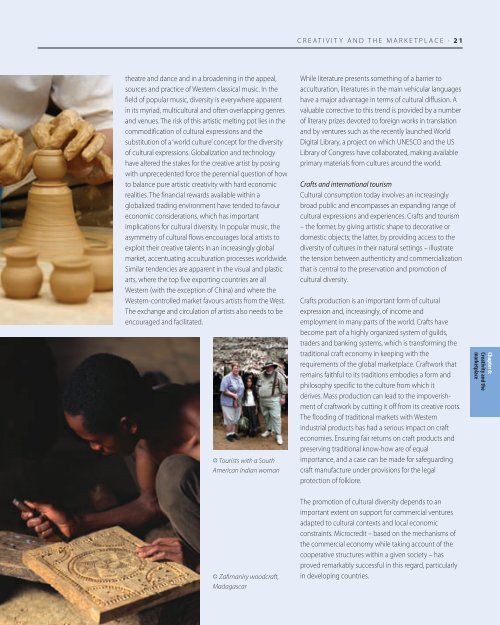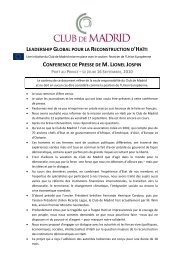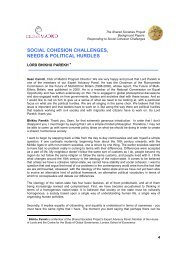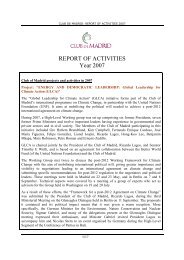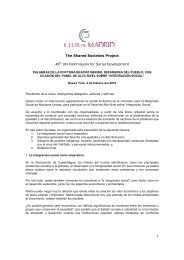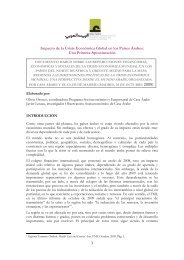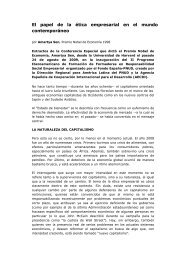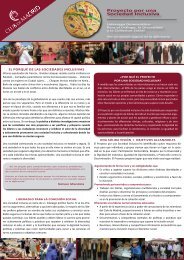Investing cultural diversity and intercultural dialogue - Business and ...
Investing cultural diversity and intercultural dialogue - Business and ...
Investing cultural diversity and intercultural dialogue - Business and ...
You also want an ePaper? Increase the reach of your titles
YUMPU automatically turns print PDFs into web optimized ePapers that Google loves.
CREATIVITY AND THE MARKETPLACE . 21<br />
theatre <strong>and</strong> dance <strong>and</strong> in a broadening in the appeal,<br />
sources <strong>and</strong> practice of Western classical music. In the<br />
field of popular music, <strong>diversity</strong> is everywhere apparent<br />
in its myriad, multi<strong>cultural</strong> <strong>and</strong> often overlapping genres<br />
<strong>and</strong> venues. The risk of this artistic melting pot lies in the<br />
commodification of <strong>cultural</strong> expressions <strong>and</strong> the<br />
substitution of a ‘world culture’ concept for the <strong>diversity</strong><br />
of <strong>cultural</strong> expressions. Globalization <strong>and</strong> technology<br />
have altered the stakes for the creative artist by posing<br />
with unprecedented force the perennial question of how<br />
to balance pure artistic creativity with hard economic<br />
realities. The financial rewards available within a<br />
globalized trading environment have tended to favour<br />
economic considerations, which has important<br />
implications for <strong>cultural</strong> <strong>diversity</strong>. In popular music, the<br />
asymmetry of <strong>cultural</strong> flows encourages local artists to<br />
exploit their creative talents in an increasingly global<br />
market, accentuating acculturation processes worldwide.<br />
Similar tendencies are apparent in the visual <strong>and</strong> plastic<br />
arts, where the top five exporting countries are all<br />
Western (with the exception of China) <strong>and</strong> where the<br />
Western-controlled market favours artists from the West.<br />
The exchange <strong>and</strong> circulation of artists also needs to be<br />
encouraged <strong>and</strong> facilitated.<br />
L Tourists with a South<br />
American Indian woman<br />
J Zafimaniry woodcraft,<br />
Madagascar<br />
While literature presents something of a barrier to<br />
acculturation, literatures in the main vehicular languages<br />
have a major advantage in terms of <strong>cultural</strong> diffusion. A<br />
valuable corrective to this trend is provided by a number<br />
of literary prizes devoted to foreign works in translation<br />
<strong>and</strong> by ventures such as the recently launched World<br />
Digital Library, a project on which UNESCO <strong>and</strong> the US<br />
Library of Congress have collaborated, making available<br />
primary materials from cultures around the world.<br />
Crafts <strong>and</strong> international tourism<br />
Cultural consumption today involves an increasingly<br />
broad public <strong>and</strong> encompasses an exp<strong>and</strong>ing range of<br />
<strong>cultural</strong> expressions <strong>and</strong> experiences. Crafts <strong>and</strong> tourism<br />
– the former, by giving artistic shape to decorative or<br />
domestic objects; the latter, by providing access to the<br />
<strong>diversity</strong> of cultures in their natural settings – illustrate<br />
the tension between authenticity <strong>and</strong> commercialization<br />
that is central to the preservation <strong>and</strong> promotion of<br />
<strong>cultural</strong> <strong>diversity</strong>.<br />
Crafts production is an important form of <strong>cultural</strong><br />
expression <strong>and</strong>, increasingly, of income <strong>and</strong><br />
employment in many parts of the world. Crafts have<br />
become part of a highly organized system of guilds,<br />
traders <strong>and</strong> banking systems, which is transforming the<br />
traditional craft economy in keeping with the<br />
requirements of the global marketplace. Craftwork that<br />
remains faithful to its traditions embodies a form <strong>and</strong><br />
philosophy specific to the culture from which it<br />
derives. Mass production can lead to the impoverish -<br />
ment of craftwork by cutting it off from its creative roots.<br />
The flooding of traditional markets with Western<br />
industrial products has had a serious impact on craft<br />
economies. Ensuring fair returns on craft products <strong>and</strong><br />
preserving traditional know-how are of equal<br />
importance, <strong>and</strong> a case can be made for safeguarding<br />
craft manufacture under provisions for the legal<br />
protection of folklore.<br />
The promotion of <strong>cultural</strong> <strong>diversity</strong> depends to an<br />
important extent on support for commercial ventures<br />
adapted to <strong>cultural</strong> contexts <strong>and</strong> local economic<br />
constraints. Microcredit – based on the mechanisms of<br />
the commercial economy while taking account of the<br />
cooperative structures within a given society – has<br />
proved remarkably successful in this regard, particularly<br />
in developing countries.<br />
Chapter 6:<br />
Creativity <strong>and</strong> the<br />
marketplace


